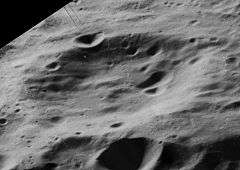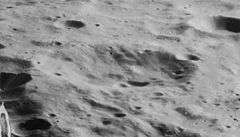Wan-Hoo (crater)
Wan-Hoo is a lunar impact crater that is located on the Moon's far side, and it cannot be seen directly from the Earth. It lies to the southwest of the huge walled plain Hertzsprung, within the outer skirt of ejecta. Just to the south-southwest of Wan-Hoo is the larger crater Paschen, and a little over two crater diameters to the northwest is Sechenov.
 LRO WAC image | |
| Coordinates | 9.8°S 138.8°W |
|---|---|
| Diameter | 52 km |
| Depth | Unknown |
| Colongitude | 139° at sunrise |
| Eponym | Wan Hu |


Like much of the surrounding terrain, this crater has been modified by the ejecta from Hertzsprung, and material from that impact encroaches along the inner walls and interior of Wan-Hoo. Attached to the east-southeastern outer rim is a large satellite crater, Evans Q, belonging to Evans farther to the east. There is also a small, relatively fresh crater attached to the southeast, and a small, cup-shaped craterlet along the western rim.
This feature was named after Wan Hu, a legendary Chinese figure who is alleged to be the first astronaut.
Satellite craters
By convention these features are identified on lunar maps by placing the letter on the side of the crater midpoint that is closest to Wan-Hoo.
| Wan-Hoo | Latitude | Longitude | Radius |
|---|---|---|---|
| T | 10.0° S | 123.4° W | 21 km |
References
- Andersson, L. E.; Whitaker, E. A. (1982). NASA Catalogue of Lunar Nomenclature. NASA RP-1097.CS1 maint: ref=harv (link)
- Blue, Jennifer (July 25, 2007). "Gazetteer of Planetary Nomenclature". USGS. Retrieved 2007-08-05.CS1 maint: ref=harv (link)
- Bussey, B.; Spudis, P. (2004). The Clementine Atlas of the Moon. New York: Cambridge University Press. ISBN 978-0-521-81528-4.CS1 maint: ref=harv (link)
- Cocks, Elijah E.; Cocks, Josiah C. (1995). Who's Who on the Moon: A Biographical Dictionary of Lunar Nomenclature. Tudor Publishers. ISBN 978-0-936389-27-1.CS1 maint: ref=harv (link)
- McDowell, Jonathan (July 15, 2007). "Lunar Nomenclature". Jonathan's Space Report. Retrieved 2007-10-24.CS1 maint: ref=harv (link)
- Menzel, D. H.; Minnaert, M.; Levin, B.; Dollfus, A.; Bell, B. (1971). "Report on Lunar Nomenclature by the Working Group of Commission 17 of the IAU". Space Science Reviews. 12 (2): 136–186. Bibcode:1971SSRv...12..136M. doi:10.1007/BF00171763.CS1 maint: ref=harv (link)
- Moore, Patrick (2001). On the Moon. Sterling Publishing Co. ISBN 978-0-304-35469-6.CS1 maint: ref=harv (link)
- Price, Fred W. (1988). The Moon Observer's Handbook. Cambridge University Press. ISBN 978-0-521-33500-3.CS1 maint: ref=harv (link)
- Rükl, Antonín (1990). Atlas of the Moon. Kalmbach Books. ISBN 978-0-913135-17-4.CS1 maint: ref=harv (link)
- Webb, Rev. T. W. (1962). Celestial Objects for Common Telescopes (6th revised ed.). Dover. ISBN 978-0-486-20917-3.CS1 maint: ref=harv (link)
- Whitaker, Ewen A. (1999). Mapping and Naming the Moon. Cambridge University Press. ISBN 978-0-521-62248-6.CS1 maint: ref=harv (link)
- Wlasuk, Peter T. (2000). Observing the Moon. Springer. ISBN 978-1-85233-193-1.CS1 maint: ref=harv (link)